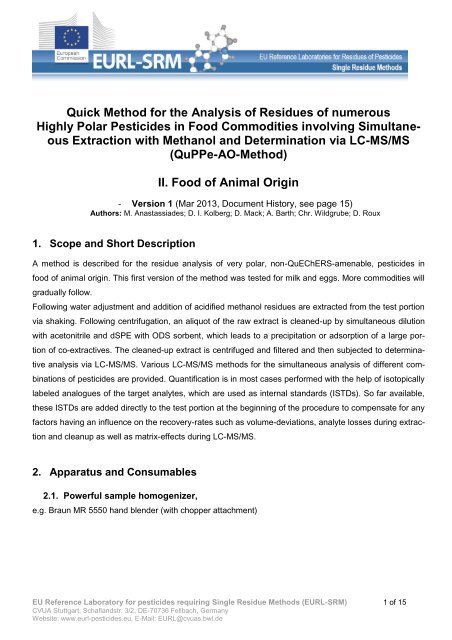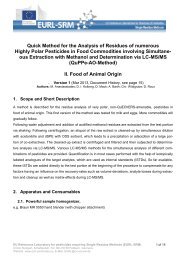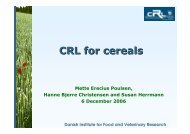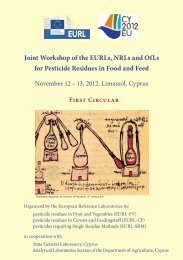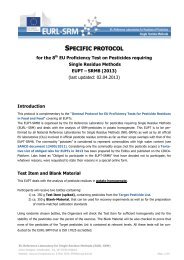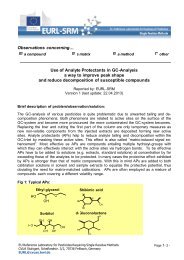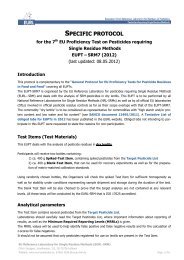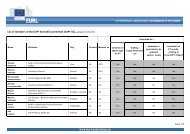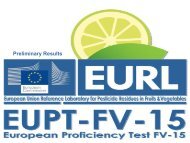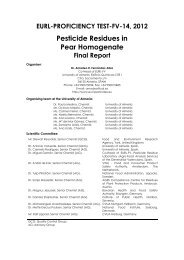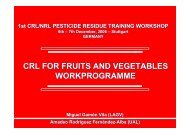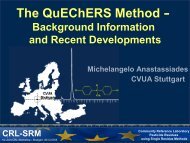QuPPe-AO - EURL | Residues of Pesticides
QuPPe-AO - EURL | Residues of Pesticides
QuPPe-AO - EURL | Residues of Pesticides
Create successful ePaper yourself
Turn your PDF publications into a flip-book with our unique Google optimized e-Paper software.
Quick Method for the Analysis <strong>of</strong> <strong>Residues</strong> <strong>of</strong> numerous<br />
Highly Polar <strong>Pesticides</strong> in Food Commodities involving Simultaneous<br />
Extraction with Methanol and Determination via LC-MS/MS<br />
(<strong>QuPPe</strong>-<strong>AO</strong>-Method)<br />
II. Food <strong>of</strong> Animal Origin<br />
- Version 1 (Mar 2013, Document History, see page 15)<br />
Authors: M. Anastassiades; D. I. Kolberg; D. Mack; A. Barth; Chr. Wildgrube; D. Roux<br />
1. Scope and Short Description<br />
A method is described for the residue analysis <strong>of</strong> very polar, non-QuEChERS-amenable, pesticides in<br />
food <strong>of</strong> animal origin. This first version <strong>of</strong> the method was tested for milk and eggs. More commodities will<br />
gradually follow.<br />
Following water adjustment and addition <strong>of</strong> acidified methanol residues are extracted from the test portion<br />
via shaking. Following centrifugation, an aliquot <strong>of</strong> the raw extract is cleaned-up by simultaneous dilution<br />
with acetonitrile and dSPE with ODS sorbent, which leads to a precipitation or adsorption <strong>of</strong> a large por-<br />
tion <strong>of</strong> co-extractives. The cleaned-up extract is centrifuged and filtered and then subjected to determina-<br />
tive analysis via LC-MS/MS. Various LC-MS/MS methods for the simultaneous analysis <strong>of</strong> different com-<br />
binations <strong>of</strong> pesticides are provided. Quantification is in most cases performed with the help <strong>of</strong> isotopically<br />
labeled analogues <strong>of</strong> the target analytes, which are used as internal standards (ISTDs). So far available,<br />
these ISTDs are added directly to the test portion at the beginning <strong>of</strong> the procedure to compensate for any<br />
factors having an influence on the recovery-rates such as volume-deviations, analyte losses during extrac-<br />
tion and cleanup as well as matrix-effects during LC-MS/MS.<br />
2. Apparatus and Consumables<br />
2.1. Powerful sample homogenizer,<br />
e.g. Braun MR 5550 hand blender (with chopper attachment)<br />
EU Reference Laboratory for pesticides requiring Single Residue Methods (<strong>EURL</strong>-SRM)<br />
CVUA Stuttgart, Schaflandstr. 3/2, DE-70736 Fellbach, Germany<br />
Website: www.eurl-pesticides.eu, E-Mail: <strong>EURL</strong>@cvuas.bwl.de<br />
1 <strong>of</strong> 15
2.2. 50 mL centrifuge tubes with screw caps,<br />
for the extraction step (5.2.1), e.g.: a) disposable 50 mL centrifuge tubes (e.g. Sarstedt / Nümbrecht,<br />
Germany, 114x28 mm, PP, article-no. 62.548.004) or b) reusable 50 mL Teflon® centrifuge tubes with<br />
screw caps (e.g. Nalgene/Rochester, USA; Oak-ridge, article-no. 3114-0050).<br />
2.3. 10 mL centrifuge tubes with screw caps,<br />
For the d-SPE step (5.2.6), e.g.: disposable 10 mL PP-tubes by Simport/Beloeil (Canada), article-no.<br />
T550-10AT<br />
2.4. Automatic pipettes,<br />
suitable for handling volumes <strong>of</strong> 10 to 100 μl, 200 to 1000 μl and 1 to 10 ml.<br />
2.5. 10 mL solvent-dispenser,<br />
for the acidified methanol (3.6).<br />
2.6. Centrifuge,<br />
suitable for the centrifuge tubes employed in the procedure (2.2) and capable <strong>of</strong> achieving > 3000 g.<br />
2.7. Syringe filters,<br />
e.g. polyester filters 0.45 µm pore size.<br />
2.8. Syringes<br />
e.g. 2 or 5 mL disposable polypropylene syringes suitable for the above mentioned filters 2.7.<br />
2.9. Autosampler vials,<br />
suitable for LC auto-samplers,<br />
Use plastic vials if pesticides that tend to interact with glass-surfaces are present (e.g. Glyphosate and<br />
Ethephon) 1 .<br />
Note:<br />
- Such interaction with glass surfaces are more pronounced when solutions have low water content<br />
and low acidity.<br />
1 The list <strong>of</strong> compounds requiring plastic vessels might not be comprehensive (this remark applies to the entire doc-<br />
ument)<br />
EU Reference Laboratory for pesticides requiring Single Residue Methods (<strong>EURL</strong>-SRM)<br />
CVUA Stuttgart, Schaflandstr. 3/2, DE-70736 Fellbach, Germany<br />
Website: www.eurl-pesticides.eu, E-Mail: <strong>EURL</strong>@cvuas.bwl.de<br />
2 <strong>of</strong> 15
2.10. Volumetric flask with stoppers,<br />
for the preparation <strong>of</strong> stock and working solutions (3.11 - 3.16), e.g. 20 mL; 25 mL; 50 mL, 100 mL glass<br />
flasks. Use plastic flasks and stoppers if pesticides that tend to interact with glass-surfaces are present<br />
(e.g. Glyphosate and Ethephon).<br />
2.11. LC-MS/MS instrumentation,<br />
See latest version <strong>of</strong> <strong>QuPPe</strong>-PO-Method<br />
3. Chemicals<br />
Unless otherwise specified, use reagents <strong>of</strong> recognized analytical grade. Take every precaution to avoid<br />
possible contamination <strong>of</strong> water, solvents, sorbents, inorganic salts, etc.<br />
3.1. Water (deionized)<br />
3.2. Methanol (HPLC quality)<br />
3.3. Acetonitrile (HPLC quality)<br />
3.4. Formic acid (concentrated; > 95%)<br />
3.5. Acetic Acid (concentrated; >98%)<br />
3.6. Acidified methanol,<br />
pipette 10 mL formic acid (3.4) in a 1000 mL volumetric flask and fill up to volume with methanol (3.2).<br />
3.7. ODS (octadecylsilane) sorbent,<br />
e.g. Polygoprep 30-300 µm Macherey-Nagel GmbH & Co KG/Düren (Germany), article-no. 711720.100).<br />
3.8. Ammonium formate (p.a.)<br />
for the LC-MS/MS eluent in Method M4<br />
3.9. LC-MS/MS mobile phases<br />
See latest version <strong>of</strong> <strong>QuPPe</strong>-PO-Method.<br />
3.10. Pesticide Standards,<br />
<strong>of</strong> known purity.<br />
EU Reference Laboratory for pesticides requiring Single Residue Methods (<strong>EURL</strong>-SRM)<br />
CVUA Stuttgart, Schaflandstr. 3/2, DE-70736 Fellbach, Germany<br />
Website: www.eurl-pesticides.eu, E-Mail: <strong>EURL</strong>@cvuas.bwl.de<br />
3 <strong>of</strong> 15
3.11. Pesticide stock solutions,<br />
See latest version <strong>of</strong> <strong>QuPPe</strong>-PO-Method. Use plastic flasks and stoppers if pesticides that tend to interact<br />
with glass-surfaces are present (e.g. Glyphosate, Ethephon).<br />
3.12. Pesticide working solutions / mixtures,<br />
See latest version <strong>of</strong> <strong>QuPPe</strong>-PO-Method. Use plastic flasks and stoppers if pesticides that tend to interact<br />
with glass-surfaces are present (e.g. Glyphosate, Ethephon).<br />
3.13. Internal Standards (ISTDs),<br />
See latest version <strong>of</strong> <strong>QuPPe</strong>-PO-Method.<br />
3.14. ISTD Stock solutions,<br />
See latest version <strong>of</strong> <strong>QuPPe</strong>-PO-Method. Use plastic flasks and stoppers if pesticides that tend to interact<br />
with glass-surfaces are present (e.g. isotope labeled Glyphosate, Ethephon).<br />
3.15. ISTD-working solution I (ISTD-WS I) for spiking samples prior to extraction,<br />
See latest version <strong>of</strong> <strong>QuPPe</strong>-PO-Method. Use plastic flasks and stoppers if pesticides that tend to interact<br />
with glass-surfaces are present (e.g. isotope labeled Glyphosate, Ethephon).<br />
3.16. ISTD-working solution II (ISTD-WS II) for preparation <strong>of</strong> calibration standards,<br />
See latest version <strong>of</strong> <strong>QuPPe</strong>-PO-Method. Use plastic flasks and stoppers if pesticides that tend to interact<br />
with glass-surfaces are present (e.g. isotope labeled Glyphosate, Ethephon).<br />
4. Disclaimer<br />
This method refers to several trade name products and instruments which are commercially available and<br />
suitable for the described procedure. This information is given for the convenience <strong>of</strong> the users <strong>of</strong> this<br />
method and does not constitute an endorsement by the <strong>EURL</strong> <strong>of</strong> the products named. The application <strong>of</strong><br />
this method may involve hazardous materials, operations and equipment. It is the responsibility <strong>of</strong> the us-<br />
ers <strong>of</strong> this method to establish appropriate safety and health practices prior to use.<br />
EU Reference Laboratory for pesticides requiring Single Residue Methods (<strong>EURL</strong>-SRM)<br />
CVUA Stuttgart, Schaflandstr. 3/2, DE-70736 Fellbach, Germany<br />
Website: www.eurl-pesticides.eu, E-Mail: <strong>EURL</strong>@cvuas.bwl.de<br />
4 <strong>of</strong> 15
5. Procedure<br />
5.1. Sample preparation<br />
To obtain representative test-portions from the laboratory sample, proceed as required by the respective<br />
regulations and guidelines. Homogenize the eggs with a hand-blender (2.1) until a free flowing mixture is<br />
obtained. Proceed similarly with non-homogenized milk (e.g. if fat has separated).<br />
5.2. Extraction / Centrifugation / Filtration<br />
5.2.1. Weigh a representative portion (ma) <strong>of</strong> the sample homogenate (5.1) into a 50 mL centrifuge tube<br />
(2.2). In case <strong>of</strong> fresh milk and fresh eggs take 10 g 0.05 g <strong>of</strong> the homogenized sample.<br />
5.2.2. Add water (3.1) to a content <strong>of</strong> ca. 10 g in total. In the case <strong>of</strong> cow milk (88 % water) add 1.2 g <strong>of</strong><br />
water and in case <strong>of</strong> chicken eggs (76% water) add 2.4 g <strong>of</strong> water.<br />
Notes:<br />
- Where no IL-ISTDs are used or where they are added after extract aliquotation, water adjustment is<br />
essential. Where the appropriate IL-ISTDs are employed before any aliquotation has taken place<br />
water adjustment is less critical and can be skipped for commodities containing ≥80% water.<br />
5.2.3. Add 10 mL acidified methanol (3.6) and 50 µL <strong>of</strong> the ISTD-WS I (3.15) containing isotopically la-<br />
beled analogues <strong>of</strong> one or more <strong>of</strong> the analytes <strong>of</strong> interest (added ISTD mass = mISTD sample ).<br />
Notes:<br />
- For screening purposes the ISTD can be alternatively added to an aliquot <strong>of</strong> the final sample extract<br />
(see 5.2.10)<br />
5.2.4. Close the tube and shake vigorously for 1 min by hand or for 5-20 minutes by a mechanical shaker.<br />
5.2.5. Centrifuge for 5 min at >3000 g.<br />
5.2.6.Transfer a 2 mL aliquot into a 10 mL centrifuge tube with screw cap (2.3), which already contains the<br />
2 mL <strong>of</strong> acetonitrile (3.3) and 100 mg <strong>of</strong> ODS sorbent (3.7).<br />
5.2.7. Close the tube and shake vigorously for 1 min by hand.<br />
5.2.8. Centrifuge (e.g. for 5 min at >3000 g).<br />
5.2.9.Filter an aliquot (ca. 3-4 mL) <strong>of</strong> the extract through a syringe filter (2.7) into a sealable storage ves-<br />
sel.<br />
5.2.10. Transfer, as required, one or more aliquots (e.g. 1 mL each) into auto-sampler vials (2.9)<br />
Notes:<br />
- The cleaned-up extract will contain ca. 0.25 g sample equivalents per mL extract (if 10 g sample<br />
are employed for extraction).<br />
- Instead <strong>of</strong> adding the ISTD at the beginning <strong>of</strong> the procedure it can be added to an aliquot (e.g. 1<br />
mL) <strong>of</strong> the final sample extract. This way the added amount <strong>of</strong> ISTD per sample can be drastically<br />
reduced (e.g. 40-fold if added to 1 mL extract). The ISTD added at this step will compensate for ma-<br />
EU Reference Laboratory for pesticides requiring Single Residue Methods (<strong>EURL</strong>-SRM)<br />
CVUA Stuttgart, Schaflandstr. 3/2, DE-70736 Fellbach, Germany<br />
Website: www.eurl-pesticides.eu, E-Mail: <strong>EURL</strong>@cvuas.bwl.de<br />
5 <strong>of</strong> 15
5.3. Blank extracts<br />
trix effects including retention-time shifts. The quantitative result should however be considered as<br />
tentative. For more accuracy samples should be re-analyzed with the ISTD being added in step<br />
5.2.3.<br />
Using suitable blank commodities (not containing any detectable residues <strong>of</strong> the analytes <strong>of</strong> interest), pro-<br />
ceed sample preparation exactly as described under 5.2 but SKIP THE ADDITION OF ISTDs.<br />
5.4. Recovery experiments<br />
See latest version <strong>of</strong> <strong>QuPPe</strong>-PO-Method.<br />
5.5. Preparation <strong>of</strong> calibration standards<br />
5.5.1. Solvent-based calibration standards<br />
An exemplary pipetting scheme for the preparation <strong>of</strong> solvent-based calibration standards is shown in Ta-<br />
ble 1. The calculation <strong>of</strong> the mass-fraction WR <strong>of</strong> the pesticide in the sample, when ISTD is used, is shown<br />
in 5.7.1.<br />
Note:<br />
- Where solvent-based calibrations are used the use <strong>of</strong> IL-ISTDs for quantification is essential as the<br />
ISTD compensates for any matrix-related signal suppressions / enhancements.<br />
5.5.2.Matrix matched calibration standards<br />
Transfer suitable aliquots <strong>of</strong> the blank extract (5.3) to auto-sampler vials and proceed as shown in Table<br />
1.<br />
The calculation <strong>of</strong> the mass-fraction WR <strong>of</strong> the pesticide in the sample using matrix-matched calibration<br />
standards, with and without the use <strong>of</strong> ISTD, is shown in 5.7.1 and 5.7.2.1 respectively.<br />
EU Reference Laboratory for pesticides requiring Single Residue Methods (<strong>EURL</strong>-SRM)<br />
CVUA Stuttgart, Schaflandstr. 3/2, DE-70736 Fellbach, Germany<br />
Website: www.eurl-pesticides.eu, E-Mail: <strong>EURL</strong>@cvuas.bwl.de<br />
6 <strong>of</strong> 15
Table 1: Exemplary pipetting scheme for the preparation <strong>of</strong> calibration standards<br />
Calibration levels<br />
in µg pesticide /mL OR<br />
in µg pesticide/ “ISTD-portion”<br />
2<br />
Corresponding conc. in<br />
sample using 10 g test<br />
portions (mg/kg)<br />
Calibration standards<br />
Solvent based (5.5.1) Matrix-matched (5.5.2)<br />
using ISTD 1 without ISTD 5 using ISTD 1<br />
0.0125 0.025 0.0625 0.0125 0.025 0.0625 0.0125 0.025 0.0625<br />
0.05 0.1 0.25 0.05 0.1 0.25 0.05 0.1 0.25<br />
Pipetting Volumes<br />
Blank extract (5.3) - - - 875 µL 875 µL 875 µL 825 µL 825 µL 825 µL<br />
1:1 (v/v) mix <strong>of</strong> water (3.1)<br />
and acidified MeOH (3.6)<br />
Pesticide working<br />
solutions<br />
(3.12) 3<br />
925 µL 900 µL 825 µL 100 µL 75 µL - 100 µL 75 µL -<br />
0.5 µg/mL 25 µL 50 µL 125 µL 25 µL 50 µl 125 µL 25 µL 50 µL 125 µL<br />
ISTD-WS II (3.16) 2,4 50 µL 50 µL 50 µL - - - 50 µL 50 µL 50 µL<br />
Total volume 1000 µL 1000 µL 1000 µL 1000 µL 1000 µL 1000 µL 1000 µL 1000 µL 1000 µL<br />
1 When employing IL-ISTDs matrix-matching and volume adjustments are <strong>of</strong> less importance as the ISTD compensates<br />
for any matrix-related signal suppressions / enhancements. Also solvent-based calibrations can be used here.<br />
Important is that a) the mass ratio <strong>of</strong> pesticide and ISTD in the respective calibration standards and b) the ratio between<br />
the ISTD mass added to the sample (5.2.3) and the ISTD mass added to the calibration standard(s) (5.5.1<br />
and 5.5.2) is known and recorded. For convenience the latter mass ratio should be kept constant throughout all calibration<br />
levels (e.g. at 40:1 when preparing calibration standards <strong>of</strong> 1 mL).<br />
2 One ISTD portion would correspond to the ISTD mass contained in 50 µL ISTD-WS II (the volume added to each<br />
calibration standard).<br />
3 The concentration <strong>of</strong> the pesticide working solution(s) should be sufficiently high to avoid excessive dilution <strong>of</strong> the<br />
blank extract which would result in matrix effect deviations.<br />
4 For calibration standards <strong>of</strong> 1 mL it is recommended to prepare the ISTD-WS II (3.16) by diluting 40-fold the ISTD-<br />
WS I (3.15). The same volume and pipette as in 5.2.3 can then be used for the preparation <strong>of</strong> the calibration standards.<br />
5 Where IL-ISTDs are not available/employed, matrix-matching via matrix-matched standards (Table 1) or the standard<br />
additions approach (5.5.3) are particularly important to compensate for matrix effects in measurement. In both<br />
cases the final extract is assumed to contain 0.25 g sample/mL (when 10 g sample are used).<br />
EU Reference Laboratory for pesticides requiring Single Residue Methods (<strong>EURL</strong>-SRM)<br />
CVUA Stuttgart, Schaflandstr. 3/2, DE-70736 Fellbach, Germany<br />
Website: www.eurl-pesticides.eu, E-Mail: <strong>EURL</strong>@cvuas.bwl.de<br />
7 <strong>of</strong> 15
5.5.3.Standard-Additions-Approach<br />
Where no appropriate ISTDs are available the method <strong>of</strong> standard additions is a very effective approach<br />
for compensating matrix-induced enhancement or suppression phenomena. As this procedure involves a<br />
linear extrapolation it is mandatory that pesticide concentrations and detection signals show a linear rela-<br />
tionship throughout the relevant concentration range. The procedure furthermore requires knowledge <strong>of</strong><br />
the approximate (estimated) residue level in the sample (wR(exp.)) as derived from a preliminary analysis.<br />
Prepare 4 vials containing equal portions <strong>of</strong> the final extract. Three <strong>of</strong> them should be spiked with increas-<br />
ing amounts <strong>of</strong> the analyte. The amounts to be added should be chosen to be close to the expected<br />
amount <strong>of</strong> the analytes in the aliquots<br />
aliquot<br />
m pest(exp<br />
.)<br />
. It is important to remain within the linear range. Prepare a<br />
working solution (3.12) <strong>of</strong> the analyte at a concentration level where e.g. 50 or 100 µL <strong>of</strong> the solution con-<br />
tain the smallest amount <strong>of</strong> analyte to be added. Below some examples <strong>of</strong> standard additions:<br />
aliquot<br />
aliquot<br />
aliquot<br />
Example A: Vial 1) no addition; vial 2) 0.5 x m pest(exp<br />
.) , vial 3) 1 x m pest(exp<br />
.) , and vial 4) 1.5 x m pest(exp<br />
.) ,<br />
aliquot<br />
aliquot<br />
aliquot<br />
Example B: Vial 1) no addition; vial 2) 1 x m pest(exp<br />
.) , vial 3) 2 x m pest(exp<br />
.) , and vial 4) 3 x m pest(exp<br />
.) .<br />
Adjust the volume within all vials by adding the corresponding solvent amounts.<br />
Table 2 shows a pipetting scheme following Example A. The calculation <strong>of</strong> the mass fraction <strong>of</strong> the pesti-<br />
cide in the sample wR is shown in 5.7.2.2.<br />
Table 2 : Exemplary pipetting scheme <strong>of</strong> a standard additions approach (for a sample extract containing 0.25 g<br />
sample equivalents per mL and an estimated residue level (wR(approx)) <strong>of</strong> 0.4 mg/kg (corresponds to 0.1 µg/mL)<br />
Additions Vial 1 Vial 2 Vial 3 Vial 4<br />
Volume <strong>of</strong> final sample extract<br />
1000 µl<br />
(= 0.25 g sample)<br />
1000 µl<br />
(= 0.25 g sample)<br />
1000 µl<br />
(= 0.25 g sample)<br />
EU Reference Laboratory for pesticides requiring Single Residue Methods (<strong>EURL</strong>-SRM)<br />
CVUA Stuttgart, Schaflandstr. 3/2, DE-70736 Fellbach, Germany<br />
Website: www.eurl-pesticides.eu, E-Mail: <strong>EURL</strong>@cvuas.bwl.de<br />
1000 µl<br />
(= 0.25 g sample)<br />
ISTD none none none none<br />
Added volume <strong>of</strong> pesticide working<br />
solution containing 1 µg/ml (3.12)<br />
std add<br />
Resulting mass ( m pest ) <strong>of</strong> pesticide<br />
added to each vial<br />
- 50 µl 100 µl 150 µl<br />
0.05 µg 0.1 µg 0.15 µg<br />
Volume <strong>of</strong> solvent 150 µl 100 µl 50 µl -<br />
Final volume 1150 µl 1150 µl 1150 µl 1150 µl<br />
8 <strong>of</strong> 15
5.6. LC-MS/MS Measurement Conditions<br />
Any suitable LC and MS/MS conditions including those proposed in the <strong>QuPPe</strong>-PO-Method may be used.<br />
For food <strong>of</strong> animal origin we have so far only tested method M 1.3 and M 4.<br />
5.6.1. Exemplary LC-MS/MS chromatograms (method M1.3)<br />
Figure 1: Chromatograms <strong>of</strong> Fosetyl, Maleic Hydrazide, HEPA, Ethephon, MPPA, Glyphosate, Glufosinate, N-<br />
Acetyl-Glufosinate, at 0.1 µg/mL in MeOH (with 1% formic acid).<br />
Fosetyl 109/ 81 T Maleic hydrazid 111/ 82 T HEPA 125/ 79 T Ethephon 143/ 107 T<br />
MPPA 151/ 63 T Glyphosate 168/ 63 T Glufosinate 180/ 63 T N-Acetyl-Glufosinate 222/ 63 T<br />
Figure 2: Chromatograms <strong>of</strong> Fosetyl, Maleic Hydrazide, HEPA, Ethephon, MPPA, Glyphosate, Glufosinate, N-<br />
Acetyl-Glufosinate, at 0.0125 µg/mL in whole cow’s milk extract.<br />
Fosetyl 109/63 Maleic hydrazid 111/82 HEPA 125/79 Ethephon 143/107<br />
MPPA 151/63 Glyphosate 168/63 Glufosinate 180/95 N-acetylglufosinate 222/136<br />
Figure 3: Chromatograms <strong>of</strong> Fosetyl-Al, Maleic Hydrazide, HEPA, Ethephon, MPPA, Glyphosate, Glufosinate, N-<br />
Acetyl-Glufosinate, at 0.0125 µg/mL in chicken eggs extract.<br />
EU Reference Laboratory for pesticides requiring Single Residue Methods (<strong>EURL</strong>-SRM)<br />
CVUA Stuttgart, Schaflandstr. 3/2, DE-70736 Fellbach, Germany<br />
Website: www.eurl-pesticides.eu, E-Mail: <strong>EURL</strong>@cvuas.bwl.de<br />
9 <strong>of</strong> 15
Fosetyl 109/63 Maleic hydrazide 111/82 HEPA 125/79 Ethephon 143/107<br />
MPPA 151/63 Glyphosate 168/63 Glufosinate 180/63 N-acetylglufosinate 222/136<br />
5.6.2. Exemplary LC-MS/MS chromatograms (method M4)<br />
Figure 4: Chromatograms <strong>of</strong> Trimethylsulfonium cation, Nereistoxin, Mepiquat, Chlormequat, Daminozide, Cyromazine,<br />
Difenzoquat at 0.1 µg/mL in MeOH (with 1% formic acid).<br />
Trimethylsulfonium 77 / 62 Nereistoxin 150/105 Mepiquat 114 / 58 Chlormequat 122 / 58<br />
Daminozide 161 / 143 Cyromazine 167/68 Difenzoquat 249 / 77<br />
EU Reference Laboratory for pesticides requiring Single Residue Methods (<strong>EURL</strong>-SRM)<br />
CVUA Stuttgart, Schaflandstr. 3/2, DE-70736 Fellbach, Germany<br />
Website: www.eurl-pesticides.eu, E-Mail: <strong>EURL</strong>@cvuas.bwl.de<br />
10 <strong>of</strong> 15
Figure 5: Chromatograms <strong>of</strong> Trimethylsulfonium cation, Nereistoxin, Mepiquat, Chlormequat, Daminozide, Cyromazine,<br />
Difenzoquat at 0.0125 µg/mL in whole cow’s milk extract.<br />
Trimethylsulfonium 77 / 62 Nereistoxin 150/105 Mepiquat 114 / 58 Chlormequat 122 / 58<br />
Daminozide 161 / 143 Cyromazine 167/.68 Difenzoquat 249 / 77<br />
Figure 6: Chromatograms <strong>of</strong> Trimethylsulfonium cation, Nereistoxin, Mepiquat, Chlormequat, Daminozide, Cyromazine,<br />
Difenzoquat at 0.0125 µg/mL in chicken eggs extract.<br />
Trimethylsulfonium 77 / 62 Nereistoxin 150/105 Mepiquat 114 / 58 Chlormequat 122 / 58<br />
Daminozide 161 / 143 Cyromazine 167/68 Difenzoquat 249 / 77<br />
EU Reference Laboratory for pesticides requiring Single Residue Methods (<strong>EURL</strong>-SRM)<br />
CVUA Stuttgart, Schaflandstr. 3/2, DE-70736 Fellbach, Germany<br />
Website: www.eurl-pesticides.eu, E-Mail: <strong>EURL</strong>@cvuas.bwl.de<br />
11 <strong>of</strong> 15
5.7. Calibration and Calculations<br />
5.7.1. Using ISTD<br />
5.7.1.1. Where ISTD is added to the sample before any aliquotation:<br />
Follow the latest version <strong>of</strong> <strong>QuPPe</strong>-PO-Method. To ensure similar concentration <strong>of</strong> the ISTD is sample<br />
extracts and calibration standards it is reasonable to prepare the calibration standards in such a way that<br />
the ratio mISTD sample / mISTD cal mix equals 40 (to account for the final volume <strong>of</strong> the raw extract <strong>of</strong> 20 mL and<br />
the 1:1 dilution during cleanup). The absolute masses <strong>of</strong> the ISTD-WS I and II do not need to be neces-<br />
sarily known.<br />
5.7.1.2. Where ISTD is added to an aliquot <strong>of</strong> the extract<br />
Follow the latest version <strong>of</strong> <strong>QuPPe</strong>-PO-Method. When adding the ISTD to an aliquot <strong>of</strong> the extract (e.g. 1<br />
mL) it is mandatory to know the exact concentration <strong>of</strong> matrix-equivalnts per mL extract. If water adjust-<br />
ment is done as described in 5.2.2, the total volume <strong>of</strong> the raw extract can be assumed to be exactly 20<br />
mL. Considering the 2-fold dilution during the cleanup step 1 mL sample extract will represent 1/40 th <strong>of</strong> the<br />
test portion (ma). The mass <strong>of</strong> the ISTD to be added to an aliquot (mISTD aliquot ) should be scaled according<br />
to the aliquot volume used (Valiquot) with the ISTD mass ratio (mISTD aliquot / mISTD cal mix ) being important for<br />
the calculation.<br />
5.7.2. Not using ISTD<br />
If no appropriate ISTDs are used it is <strong>of</strong> high importance to properly compensate for matrix effects. For the<br />
compensation <strong>of</strong> matrix effects matrix-matched calibrations (5.5.2) and the standard additions approach<br />
(5.5.3) are recommended. In both cases the assumption is made that the total volume <strong>of</strong> the raw sample<br />
extract is exactly 20 mL, which is then diluted by a factor <strong>of</strong> 2. Adjustment <strong>of</strong> the water content (and ex-<br />
tract volume) in the sample is thus paramount.<br />
5.7.2.1. Calculations when employing matrix-matched calibration without ISTD<br />
Follow the latest version <strong>of</strong> <strong>QuPPe</strong>-PO-Method.<br />
In the formula multiply Vend by two to account for the 2-fold dilution in the cleanup step.<br />
EU Reference Laboratory for pesticides requiring Single Residue Methods (<strong>EURL</strong>-SRM)<br />
CVUA Stuttgart, Schaflandstr. 3/2, DE-70736 Fellbach, Germany<br />
Website: www.eurl-pesticides.eu, E-Mail: <strong>EURL</strong>@cvuas.bwl.de<br />
12 <strong>of</strong> 15
5.7.2.2. Calculations when employing the standard additions approach<br />
The standard additions approach is the method <strong>of</strong> choice where no appropriate IL-ISTD is available. This<br />
approach typically compensates matrix effect better than matrix-matched calibrations (5.5.2). The mass<br />
fraction <strong>of</strong> the pesticide in the sample (wR) is calculated via linear regression as shown in the latest ver-<br />
sion <strong>of</strong> <strong>QuPPe</strong>-PO-Method.<br />
In the formula multiply Vend by two to account for the 2-fold dilution in the cleanup step.<br />
5.8. Validation Data<br />
5.8.1.Method 1.3 ( “Glyphosate & Co”)<br />
Table 3 : Recoveries <strong>of</strong> analytes <strong>of</strong> method M1.3 in milk and eggs.<br />
Compound ISTD used n<br />
Recovery 0.1 mg/kg<br />
in whole cow milk<br />
Recovery mean<br />
[%]<br />
RSD [%]<br />
Recovery 0.1 mg/kg<br />
in chicken eggs<br />
Recovery mean<br />
[%]<br />
EU Reference Laboratory for pesticides requiring Single Residue Methods (<strong>EURL</strong>-SRM)<br />
CVUA Stuttgart, Schaflandstr. 3/2, DE-70736 Fellbach, Germany<br />
Website: www.eurl-pesticides.eu, E-Mail: <strong>EURL</strong>@cvuas.bwl.de<br />
RSD [%]<br />
Fosetyl Yes 5 99 1.9 104 1.9<br />
Maleic hydrazide Yes 5 106 3.6 107 4.5<br />
HEPA Yes 5 105 1.2 102 3.2<br />
Ethephon Yes 5 99 4.0 114 4.4<br />
MPPA Yes 5 103 4.7 100 7.7<br />
Glyphosate Yes 5 196 9.6 117 1.0<br />
Glufosinate Yes 5 94 8.5 100 4.1<br />
N-Acetyl-Glufosinate Yes 5 103 1.9 104 3.0<br />
13 <strong>of</strong> 15
5.8.2. Method 4 (“Quats & Co”)<br />
Table 4 : Recoveries <strong>of</strong> analytes <strong>of</strong> Method M4 in milk and eggs.<br />
Trimethylsulfonium<br />
ISTD used n<br />
No, (matrix<br />
matched)<br />
Recovery 0.1 mg/kg<br />
in milk<br />
Recovery mean<br />
[%]<br />
RSD [%]<br />
Recovery 0.1 mg/kg<br />
in eggs<br />
Recovery mean<br />
[%]<br />
EU Reference Laboratory for pesticides requiring Single Residue Methods (<strong>EURL</strong>-SRM)<br />
CVUA Stuttgart, Schaflandstr. 3/2, DE-70736 Fellbach, Germany<br />
Website: www.eurl-pesticides.eu, E-Mail: <strong>EURL</strong>@cvuas.bwl.de<br />
RSD [%]<br />
5 99 0.7 90 1.1<br />
Nereistoxin Yes 5 98 1.8 98 2.8<br />
Mepiquat Yes 5 98 2.1 100 1.4<br />
Chlormequat Yes 5 102 1.5 98 1.7<br />
Daminozide Yes 5 90 3.7 91 7.2<br />
Cyromazine Yes 5 100 0.8 104 2.4<br />
Difenzoquat<br />
6. References<br />
No, (matrix<br />
matched)<br />
5 92 2.4 78 1.6<br />
Anastassiades, M and Mack, D (2008); New Developments in the Analysis <strong>of</strong> <strong>Pesticides</strong> Typically not Covered by<br />
Multiresidue Methods; European Pesticide Residue Workshop, EPRW 2008, Berlin, oral presentation O1, Book <strong>of</strong><br />
Abstracts<br />
Kolberg DI, Mack D, Anastassiades M, Hetmanski MT, Fussell RJ, Meijer T, Mol HG. Anal Bioanal Chem.<br />
404(8):2465-74 (2012); Development and independent laboratory validation <strong>of</strong> a simple method for the determination<br />
<strong>of</strong> paraquat and diquat in potato, cereals and pulses<br />
Alder L. and Startin J. R. (2005); Determination <strong>of</strong> Chlormequat and Mepiquat in Foods by Liquid Chromatography/Mass<br />
Spectrometry or Liquid Chromatography/Tandem Mass Spectrometry: Interlaboratory Study; Journal <strong>of</strong><br />
<strong>AO</strong>AC International Vol. 88, No. 6: 1762-1776<br />
Vahl, M. et al. (1998); Analysis <strong>of</strong> Chlormequat residues in grain using liquid chromatography-mass spectrometry<br />
(LC-MS/MS); Fresenius J Anal Chem 361:817-820<br />
14 <strong>of</strong> 15
Table 5: Document History<br />
Action When? Version<br />
Development <strong>of</strong> Method by the <strong>EURL</strong>-SRM 2012 -<br />
Drafting <strong>of</strong> V1 2012-2013<br />
Placing <strong>of</strong> V1 in <strong>EURL</strong>-Website Feb. 2013<br />
EU Reference Laboratory for pesticides requiring Single Residue Methods (<strong>EURL</strong>-SRM)<br />
CVUA Stuttgart, Schaflandstr. 3/2, DE-70736 Fellbach, Germany<br />
Website: www.eurl-pesticides.eu, E-Mail: <strong>EURL</strong>@cvuas.bwl.de<br />
V1<br />
15 <strong>of</strong> 15


